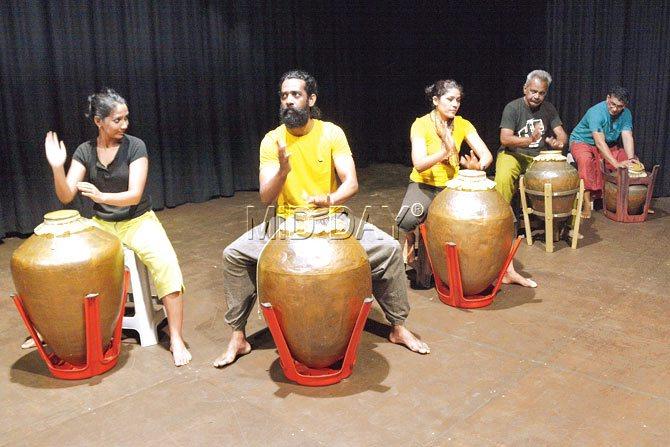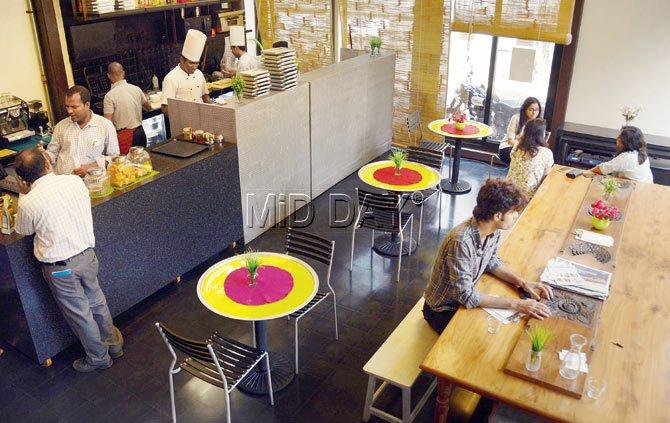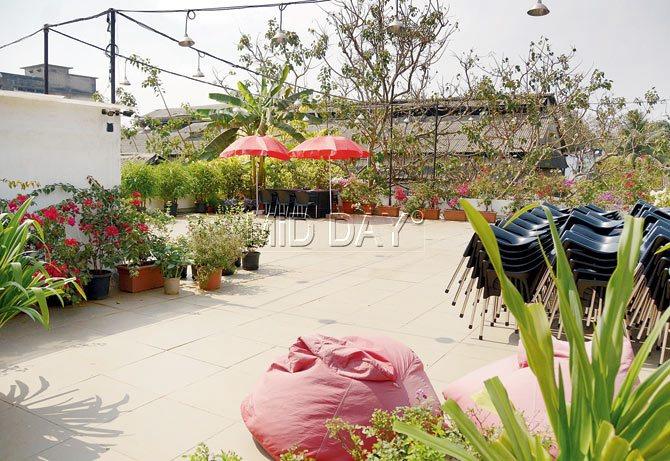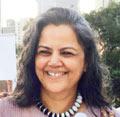Pondicherry-based Adishakti Laboratory for Theatre Arts & Research’s act, Ganapati will tell the story of the elephant God using rhythm, at a a new performance venue

Tonight, Mumbai’s theatre buffs will be treated to Ganapati, one of the most popular acts by Pondicherry-based Adishakti Laboratory for Theatre Arts & Research. The site, located on the outskirts of the Union Territory, is home to a performing arts company that engages in creating acts, researching genres and disciplines and conducting residency programs too. With over 100 shows being performed since 1999, the production emerged from director Veenapani Chawla’s (the veteran theatre artiste, has conceptualised, choreographed and directed the act) research project on rhythm as a text in Koodiyattam (traditional theatre performed in Kerala) and contemporary theatre.

Members of Adishakti rehearse at G5A, a day ahead of their performance. Pic/Pradeep Dhivar
ADVERTISEMENT
The act
“The performance is an interpretation of birth stories related to the myths of Ganapati, (the elephant god) from the Vedic cycle. It tells the story of artisans who are building a sculpture of Ganapati. It looks at Ganapati, not as a god but a concept. It teaches you to be accepting of others,” shares Vinay Kumar, a senior member of Adishakti and also a performer in the production. “Many things about Ganapati arouse interest. For example, Parvati created Ganapati single-handedly without the involvement of man. Shiva, in his rage, cut off the child’s head and replaced it with that of an elephant,” he adds, in between rehearsals at the venue.

A scene from the performance that features Ganapati’s conversation with the artisan. FILE PIC
The six performers, who are not professional drummers but actors, have trained hard for the act. The rhythms used in this piece have been evolved from Koodiyattam music and folk tunes from various parts of South Asia. “They learnt drumming for over a year and a half for the performance. It took about two years to put this production together. The verbal text is minimal. We needed actors because the production also requires expression and movement,” Kumar reveals.
The venue
Ganapati will be performed at G5A, a new venue for contemporary arts located in Laxmi Mills compound in Mahalaxmi. “A friend of ours from Mumbai recommended the new space. Our production depends heavily on lighting, so we thought the Black Box Theatre would work perfectly for us,” says Kumar. The theatre, we’re told, boasts of high quality acoustics and has hosted live performers like singer, Hariharan before. When we entered the space, which opened in November 2015, we instantly liked the large windows that filled a bright café with light. On a quick tour, we were impressed with the terrace that houses multiple flowering plants, and can be used as a venue for performances with the option of chaired seating or low seating, with mattresses.

The cafe at G5A
Anuradha Parikh, founder of the Anuradha Trust that runs G5A says, “The project has been in the pipeline for four-five years. My mother started the Mohile Parikh Centre, 26 years ago. This was the pre-Internet period. It helped accessing and understanding art in a way that wasn’t restricted attending an exhibition in a gallery. We found that the audience base was also constantly changing. Initially, it comprised students of art and also connoisseurs, through the NCPA where we were located, and gradually, we found general public getting interested. A large part of the city that is not part of the art circuit should have access to these things. We began working with NGOs and especially with children from disadvantaged communities. We wanted to create our own space with less restriction and less formality. We had this old warehouse and I thought being in this geography would help us reach a different mix of audience.”

The terrace performance area where morning recitals are a regular feature. Pics/Pradeep Dhivar
The trust has also started community-based initiatives. One of them is the South Ward Carnival. “We are looking at various communities in our neighbourhood including the Kolis, the mill workers, the transient population of the working professionals and the residential. As a part of a mapping project, we interviewed close to 70 stakeholders from different segments of society. We did a physical mapping to have an impressionist idea of what the neighbourhood looks like. A team of social workers prepared a questionnaire to understand their context, their aspirations and issues. One of the issues that came up was waste management. We thought that this is something that’s affecting people across the city,” shares Parikh. “We want to build a rapport with the neighbouring communities and bring them aboard to be partners so that they have a sense of ownership,” she adds.

Anuradha Parikh, G5A
Making the arts matter
Ganapati will be the first theatrical performance at the venue, which has earlier hosted musical performances. “We are not just a place for hire. We want it to be a place where people feel differently. We are still slow on our curating programmes. We want to be careful, resources are limited and we want to be able to sustain this kind of engagement. The space allows you to transform it in any way you wish to. Currently, we don’t have fancy green rooms and other facilities that seasoned venues may offer,” Parikh tells us. “It’s a centre of contemporary arts. We are looking at people who want to define the contemporary as well as the traditional and experiment with them meaningfuly. We choose to refuse events that don’t fit in this process. Mainstream genres like Bollywood, have multiple options available to them. They don’t need our support. We are looking at the arts as a whole because we want to encourage interdisciplinary stuff and dialogue,” she concludes.
 Subscribe today by clicking the link and stay updated with the latest news!" Click here!
Subscribe today by clicking the link and stay updated with the latest news!" Click here!







